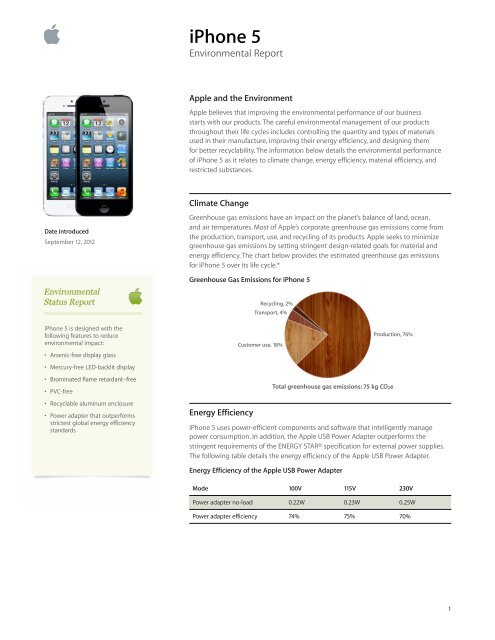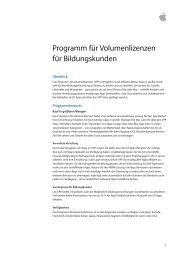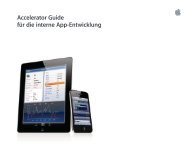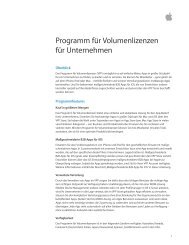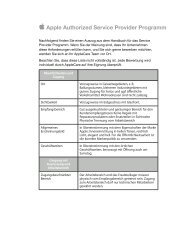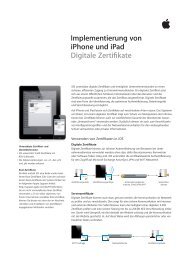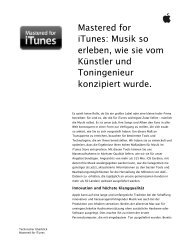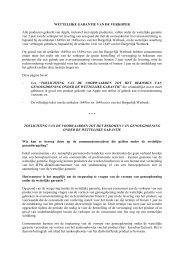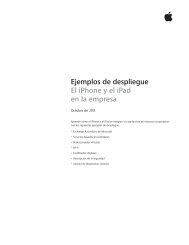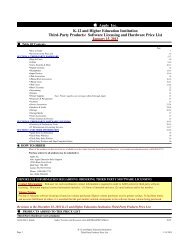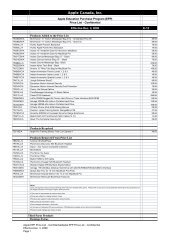iPhone 5 - Apple
iPhone 5 - Apple
iPhone 5 - Apple
You also want an ePaper? Increase the reach of your titles
YUMPU automatically turns print PDFs into web optimized ePapers that Google loves.
Date introduced<br />
September 12, 2012<br />
<strong>iPhone</strong> 5 is designed with the<br />
following features to reduce<br />
environmental impact:<br />
• Arsenic-free display glass<br />
• Mercury-free LED-backlit display<br />
• Brominated flame retardant–free<br />
• PVC-free<br />
• Recyclable aluminum enclosure<br />
• Power adapter that outperforms<br />
strictest global energy efficiency<br />
standards<br />
<strong>iPhone</strong> 5<br />
Environmental Report<br />
<strong>Apple</strong> and the Environment<br />
<strong>Apple</strong> believes that improving the environmental performance of our business<br />
starts with our products. The careful environmental management of our products<br />
throughout their life cycles includes controlling the quantity and types of materials<br />
used in their manufacture, improving their energy efficiency, and designing them<br />
for better recyclability. The information below details the environmental performance<br />
of <strong>iPhone</strong> 5 as it relates to climate change, energy efficiency, material efficiency, and<br />
restricted substances.<br />
Climate Change<br />
Greenhouse gas emissions have an impact on the planet’s balance of land, ocean,<br />
and air temperatures. Most of <strong>Apple</strong>’s corporate greenhouse gas emissions come from<br />
the production, transport, use, and recycling of its products. <strong>Apple</strong> seeks to minimize<br />
greenhouse gas emissions by setting stringent design-related goals for material and<br />
energy efficiency. The chart below provides the estimated greenhouse gas emissions<br />
for <strong>iPhone</strong> 5 over its life cycle.*<br />
Greenhouse Gas Emissions for <strong>iPhone</strong> 5<br />
Energy Efficiency<br />
Recycling, 2%<br />
Transport, 4%<br />
Customer use, 18%<br />
<strong>iPhone</strong> 5 uses power-efficient components and software that intelligently manage<br />
power consumption. In addition, the <strong>Apple</strong> USB Power Adapter outperforms the<br />
stringent requirements of the ENERGY STAR® specification for external power supplies.<br />
The following table details the energy efficiency of the <strong>Apple</strong> USB Power Adapter.<br />
Energy Efficiency of the <strong>Apple</strong> USB Power Adapter<br />
Production, 76%<br />
Total greenhouse gas emissions: 75 kg CO2e<br />
Mode 100V 115V 230V<br />
Power adapter no-load 0.22W 0.23W 0.25W<br />
Power adapter efficiency 74% 75% 70%<br />
1
Battery chemistry<br />
• Lithium-ion polymer<br />
• Free of lead, cadmium, and mercury<br />
U.S. retail packaging of <strong>iPhone</strong> 5 is 27 percent<br />
lighter and consumes 41 percent less volume<br />
than the first-generation <strong>iPhone</strong> packaging.<br />
Material Efficiency<br />
<strong>Apple</strong>’s ultracompact product and packaging designs lead the industry in material<br />
efficiency. Reducing the material footprint of a product helps maximize shipping<br />
efficiency. It also helps reduce energy consumed during production and material<br />
waste generated at the end of the product’s life. <strong>iPhone</strong> 5 is made of aluminum and<br />
other materials highly desired by recyclers. The chart below details the materials used<br />
in this model.<br />
Material Use for <strong>iPhone</strong> 5<br />
Other, 2g<br />
Plastic, 5g<br />
Display, 11g<br />
Circuit boards, 13g<br />
Packaging<br />
The packaging for <strong>iPhone</strong> 5 is highly recyclable, and its retail box is made primarily from<br />
bio-based materials, including fiberboard containing 90 percent post-consumer recycled<br />
content. In addition, the <strong>iPhone</strong> 5 packaging is extremely material efficient, allowing<br />
more units to be transported in a single shipping container. The following table details<br />
the materials used in <strong>iPhone</strong> 5 packaging.<br />
Packaging Breakdown for <strong>iPhone</strong> 5 (U.S. Configurations)<br />
Material Retail box<br />
Paper (fiberboard, paperboard) 121g<br />
High-impact polystyrene 25g<br />
Other plastics 3g<br />
Restricted Substances<br />
<strong>Apple</strong> has long taken a leadership role in restricting harmful substances from its<br />
products and packaging. As part of this strategy, all <strong>Apple</strong> products comply with the<br />
strict European Directive on the Restriction of the Use of Certain Hazardous Substances<br />
in Electrical and Electronic Equipment, also known as the RoHS Directive. Examples of<br />
materials restricted by RoHS include lead, mercury, cadmium, hexavalent chromium, and<br />
the brominated flame retardants (BFRs) PBB and PBDE. <strong>iPhone</strong> 5 goes even further than<br />
the requirements of the RoHS Directive by incorporating the following more aggressive<br />
restrictions:<br />
• Arsenic-free display glass<br />
• Mercury-free LED-backlit display<br />
• BFR–free<br />
• PVC-free<br />
Glass, 18g<br />
Battery, 24g<br />
Aluminum, 21g<br />
Stainless steel, 18g<br />
2
MacBook<br />
Recycling<br />
Through ultra-efficient design and the use of highly recyclable materials, <strong>Apple</strong> has<br />
minimized material waste at the product’s end of life. In addition, <strong>Apple</strong> offers and<br />
participates in various product take-back and recycling programs in 95 percent of<br />
the regions where <strong>Apple</strong> products are sold. All products are processed in the country<br />
or region in which they are collected. For more information on how to take advantage<br />
of these programs, visit www.apple.com/recycling.<br />
Definitions<br />
Greenhouse gas emissions: Estimated emissions are calculated in accordance with<br />
guidelines and requirements as specified by ISO 14040 and ISO 14044. Calculation<br />
includes emissions for the following life-cycle phases contributing to Global Warming<br />
Potential (GWP 100 years) in CO2 equivalency factors (CO2e):<br />
• Production: Includes the extraction, production, and transportation of raw materials, as<br />
well as the manufacture, transport, and assembly of all parts and product packaging.<br />
• Transport: Includes air and sea transportation of the finished product and its<br />
associated packaging from manufacturing site to continental distribution hubs.<br />
Transport of products from distribution hubs to end customer is not included.<br />
• Customer use: User power consumption assumes a three-year period. Product use<br />
scenarios are modeled on data that reflects intensive daily use of the product.<br />
Geographic differences in the power grid mix have been accounted for at a<br />
continental level.<br />
• Recycling: Includes transportation from collection hubs to recycling centers, and the<br />
energy used in mechanical separation and shredding of parts.<br />
Energy efficiency terms: The energy efficiency values for the <strong>Apple</strong> USB Power Adapter<br />
are based on the ENERGY STAR Program Requirements for Single Voltage External AC-DC<br />
and AC-AC Power Supplies. For more information, visit www.energystar.gov.<br />
• Power adapter no-load: Condition in which the <strong>Apple</strong> USB Power Adapter is<br />
connected to AC power, but not connected to <strong>iPhone</strong>.<br />
• Power adapter efficiency: Average of the power adapter’s measured efficiency when<br />
tested at 100 percent, 75 percent, 50 percent, and 25 percent of the power adapter’s<br />
rated output current.<br />
Restricted substances: <strong>Apple</strong> defines a material as BFR-free and PVC-free if it contains<br />
less than 900 parts per million (ppm) of bromine and of chlorine.<br />
* Greenhouse gas emissions based on evaluation of <strong>iPhone</strong> 5 with 64GB capacity.<br />
© 2012 <strong>Apple</strong> Inc. All rights reserved.<br />
3


